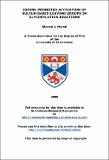Files in this item
Iodine-promoted activation of sulfur-based leaving groups in glycosylation reactions
Item metadata
| dc.contributor.advisor | Field, Rob | |
| dc.contributor.author | Marsh, Steven J. | |
| dc.coverage.spatial | 224 p. | en_US |
| dc.date.accessioned | 2017-06-12T13:07:08Z | |
| dc.date.available | 2017-06-12T13:07:08Z | |
| dc.date.issued | 2000 | |
| dc.identifier | uk.bl.ethos.630499 | |
| dc.identifier.uri | https://hdl.handle.net/10023/10985 | |
| dc.description.abstract | Further to previous work by the Field group on the iodine-mediated activation of benzyl ether-protected ('armed') thiogalactosides, a variety of ester-protected ('disarmed') β-D- thiogalactoside derivatives containing a second sulfur atom in the aglycon were prepared and characterised, and activation of these with iodine was attempted. O-Ethyl S-(2,3,4,6-tetra-O-acetyl-β-D- thiogalactopyranosyl) dithiocarbonate (26) and O-isopropyl S-(2,3,4,6-tetra-O-acetyl-β-D-thiogalactopyranosyl) dithiocarbonate (31) were prepared and found not to undergo methanolysis in the presence of iodine, or iodine in combination with DDQ. Methylthiomethyl 2,3,4,6-tetra-O-acetyl-β-D-thio-galactopyranoside (53) and ethylthioalkyl 2,3,4,6-tetra-O-acetyl-β-D-thiogalactopyranosides 38-41 were prepared and found not to undergo iodine-mediated methanolysis. Of the mercaptoalkyl 2,3,4,6-tetra-O-acetyl-β-D-thiogalactosides 52-55, mercaptopropyl 2,3,4,6-tetra-O-acetyl-β-D-thiogalactopyranoside (53) and mercaptobutyl 2,3,4,6-tetra-O-acetyl-β-D-thiogalactopyranoside (54) were found to glycoslate cyclohexanol, but with significant degradation observed by thin layer chromatography. Mercaptopropyl 2,3,4,6-tetra-O-benzoyl-β-D-thiogalactopyranoside (64) and mercaptobutyl 2,3,4,6-tetra-O-benzoyl-β-D-thiogalactopyranoside (65) were found to glycosylate cyclohexanol with no significant degradation. Carbohydrate acceptors methyl 2,3,4-tri-O-benzyl-α-D-mannopyranoside (72), methyl 2,3,4-tri-O-benzoyl-α-D-glucopyranoside (73), methyl 6-O-benzoyl-2,3-di-O-benzyl-β-D-galactopyranoside (74) and methyl 2,4,6-tri-O-benzoyl-β-D-galactopyranoside (75) were prepared. Upon attempts at iodine-mediated glycosylation of these with 64, only the primary mannose acceptor 72 was glycosylated to a significant extent. An NMR study of the IH methylene resonances of ethylthiobutyl 2,3,4,6-tetra-O-acetyl-β-D- thiogalactopyranoside (40) showed that the remote sulfide group of this compound complexes significantly with iodine, whilst the anomeric sulfur does not. It has also been demonstrated that 'armed' glycosyl sulfoxides can be activated with iodine or iodine monobromide. Ethyl 2,3,4,6-tetra- O-benzyl-α-D-thiomannopyranoside S-oxide (114) was prepared and found to give unusually high β-stereocontrol in iodine mediated mannosylation of acceptors 72, 73 and 74, as compared with excellent α-stereocontrol with acceptor 75. Both the quantity and nucleophilicity of the glycosyl acceptors and the presence of potassium carbonate affected the speed of activation of the sulfoxides, and the anomeric stereocontrol in the products. It is proposed that reversible formation of the hypoiodites of the acceptors may be the reason for these observations. | en_US |
| dc.language.iso | en | en_US |
| dc.publisher | University of St Andrews | |
| dc.subject.lcc | QD325.M2 | |
| dc.subject.lcsh | Glycosides | en |
| dc.title | Iodine-promoted activation of sulfur-based leaving groups in glycosylation reactions | en_US |
| dc.type | Thesis | en_US |
| dc.contributor.sponsor | Biotechnology and Biological Sciences Research Council (BBSRC) | en_US |
| dc.type.qualificationlevel | Doctoral | en_US |
| dc.type.qualificationname | PhD Doctor of Philosophy | en_US |
| dc.publisher.institution | The University of St Andrews | en_US |
This item appears in the following Collection(s)
Items in the St Andrews Research Repository are protected by copyright, with all rights reserved, unless otherwise indicated.

